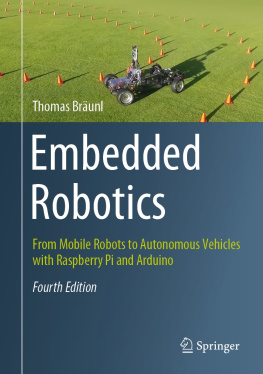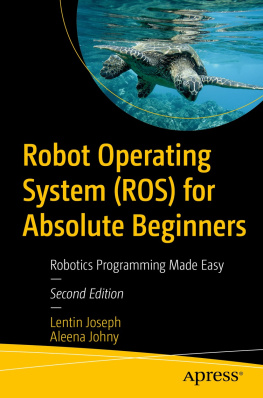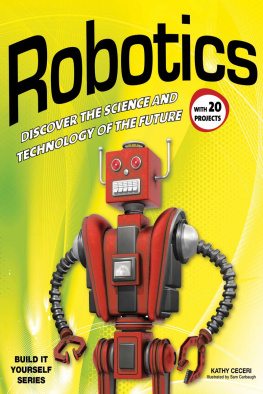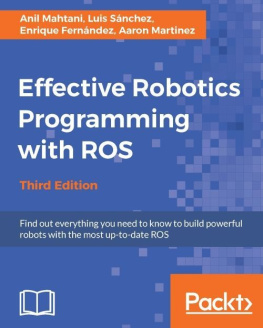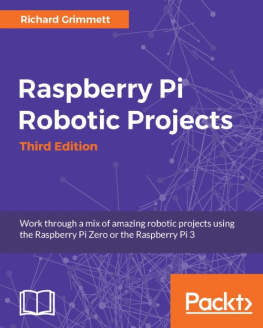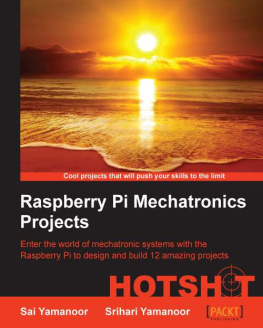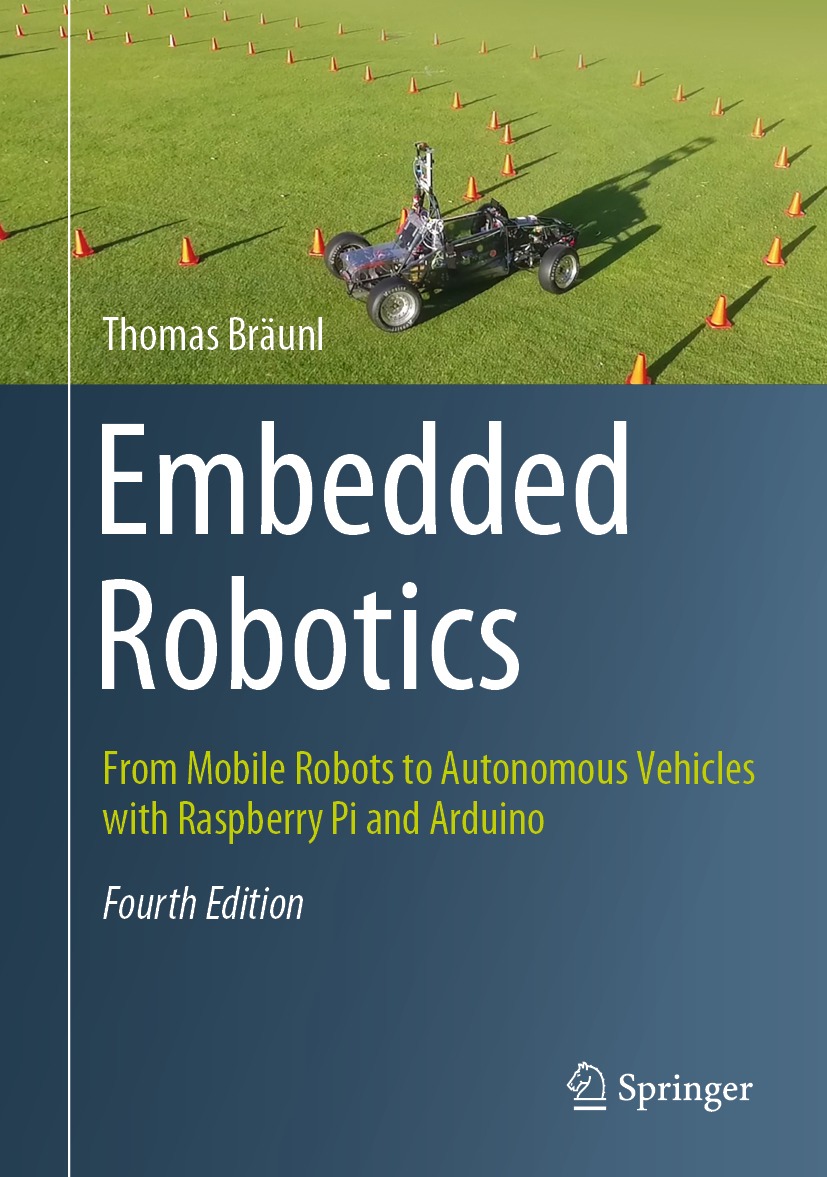Thomas Brunl
Embedded Robotics
From Mobile Robots to Autonomous Vehicles with Raspberry Pi and Arduino
4th ed. 2022

Logo of the publisher
Thomas Brunl
School of Engineering, The University of Western Australia, Perth, WA, Australia
ISBN 978-981-16-0803-2 e-ISBN 978-981-16-0804-9
https://doi.org/10.1007/978-981-16-0804-9
The Editor(s) (if applicable) and The Author(s), under exclusive license to Springer Nature Singapore Pte Ltd. 2019, 2022
This work is subject to copyright. All rights are solely and exclusively licensed by the Publisher, whether the whole or part of the material is concerned, specifically the rights of translation, reprinting, reuse of illustrations, recitation, broadcasting, reproduction on microfilms or in any other physical way, and transmission or information storage and retrieval, electronic adaptation, computer software, or by similar or dissimilar methodology now known or hereafter developed.
The use of general descriptive names, registered names, trademarks, service marks, etc. in this publication does not imply, even in the absence of a specific statement, that such names are exempt from the relevant protective laws and regulations and therefore free for general use.
The publisher, the authors and the editors are safe to assume that the advice and information in this book are believed to be true and accurate at the date of publication. Neither the publisher nor the authors or the editors give a warranty, expressed or implied, with respect to the material contained herein or for any errors or omissions that may have been made. The publisher remains neutral with regard to jurisdictional claims in published maps and institutional affiliations.
This Springer imprint is published by the registered company Springer Nature Singapore Pte Ltd.
The registered company address is: 152 Beach Road, #21-01/04 Gateway East, Singapore 189721, Singapore
Preface
This book gives a practical, in-depth introduction to embedded systems and autonomous robots, using the popular Raspberry Pi and Arduino microcontrollers. We demonstrate how to build a variety of mobile robots using a combination of these controllers, together with powerful sensors and actuators. Numerous application examples are given for mobile robots, which can be tested either on the real robots or on our freely available simulation system EyeSim.
This book combines teaching and research materials and can be used for courses in embedded systems as well as in robotics and automation. We see laboratories as an essential teaching and learning method in this area and encourage everybody to reprogram and rediscover the algorithms and systems presented in this book.
Although we like simulations for many applications and treat them in quite some depth in several places in this book, we do believe that students should also be exposed to real hardware in both areas, embedded systems and robotics. This will deepen their understanding of the subject area and, of course, create a lot more fun, especially when experimenting with small mobile robots.
We started this robotics endeavor over twenty years ago, when we first interfaced a digital image sensor to our own processor board. The EyeBot-1 was based on a Motorola 68332 and our own operating system RoBIOS. The controller was soon followed by a variety of driving, walking, flying, swimming and diving robots that we called the EyeBot family. More powerful (and more expensive) controller architectures followed, until the availability of cheap, powerful boards like the Raspberry Pi and the Arduino Uno let us reconsider our approach. We redesigned our robot family around these popular controllers, but maintained the look and feel of our easy-to-use operating software.
Even on the simulation side, we have gone new ways. Our original stand-alone robot simulation has now been replaced by our new EyeSim VR package, which uses the Unity game environment with a much more realistic physics engine. The companion book Robot Adventures in Python and C (Springer 2020) concentrates on the software aspect of mobile robots and extends the hardware/software approach of this book.
For any embedded application, the processor power (and cost) needs to match to the given problem. For low-level control of a mobile robot with two DC motors and a few simple sensors, an 8-bit controller such as the Arduino might be sufficient. However, if we want to do image processing or learning, we need a more powerful controller like the 32-bit Raspberry Pi.
The EyeBot family consists of mobile robots with all sorts of propulsion systems. We and numerous other universities use these robots and simulation systems for laboratory experiments in embedded systems as part of the computer engineering, electrical engineering and mechatronics curriculum.
Thomas Brunl
Perth, Australia
Acknowledgements
A number of colleagues and students contributed to the chapters, software systems and robotics projects presented in this book.
Working on the RoBIOS robot operating system were Remi Keat (base system), Marcus Pham (high-level control), Franco Hidalgo (low-level control) and Klaus Schmitt (driving routines).
The EyeBot controller board layout was done by Ivan Neubronner, and the EyeSim VR simulator was implemented by Travis Povey (Unity), Joel Frewin (robot models and applications), Michael Finn (terrain, underwater, swarms) and Alexander Arnold (VR).
The following colleagues and former students contributed to this book: Adrian Boeing on the evolution of walking gaits, Mohamed Bourgou on car detection and tracking, Christoph Braunschdel on PID control graphs, Louis Gonzalez and Michael Drtil on AUVs, James Ng on Bug and Brushfire algorithms, David Venkitachalam on genetic algorithms, Joshua Petitt on DC motors, Bernhard Zeisl on lane detection, Alistair Sutherland on balancing robots, Jordan King on traffic sign recognition and Nicholas Burleigh on deep learning for autonomous driving.
Additional Materials
Thomas Brunl
All system software discussed in this book, the RoBIOS operating system, C/C++ compilers for Windows, MacOS and Linux, system tools, image processing tools, simulation system, and a large collection of example programs are available free from:
http://robotics.ee.uwa.edu.au/eyebot/
http://robotics.ee.uwa.edu.au/eyesim/
Software specific to the Raspberry Pi and Arduino (Nano) controllers can be downloaded from:
http://robotics.ee.uwa.edu.au/rasp/
http://robotics.ee.uwa.edu.au/nano/
As further reading, please refer to our companion book on programming of mobile robots: Robot Adventures in Python and C. This book makes heavy use of the EyeSim simulator, so it can be used for practical experiments without the need for a physical robot.
Perth, Australia
January 2022
Contents
Part I: Embedded Systems
Part II: Robot Hardware
Part III: Robot Software
Part IV: Artificial Intelligence
The Author(s), under exclusive license to Springer Nature Singapore Pte Ltd. 2022

